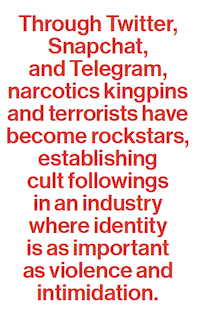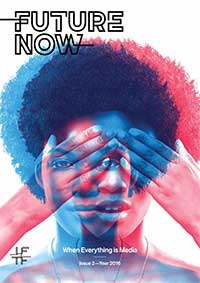Future Now
The IFTF Blog
The Underworld Wide Web
Good things you can learn from bad people
With her custom-made pink Kalashnikov strapped across her chest, Claudia Ochoa Felix, aka the Kim Kardashian of organized crime, holds her iPhone up for a selfie. The alleged sicaria (hitwoman) and mother of three has thousands of followers, and Felix is happy to keep them entertained. Gaining infamy for an Instagram post featuring her young son blanketed in a pile of cash, Felix ensures the world sees only what she wants it to see. After all, it’s not just part of her image; it’s business. In a line of work dependent on the projection of power, criminals use social media to exude influence, intimidate rival gangs, and connect with their clients.
Through Twitter, Snapchat, and Telegram, narcotics kingpins and terrorists have become rock stars, establishing cult followings in an industry where identity is as important as violence. For these deviant actors, ambient communications technology not only bolsters their images in front of a mass-audience, it also facilitates intimate connections that can be used to raise funds, coordinate attacks, and target victims. Operational logistics, once orchestrated by terrorists over coffee tables in safe houses, can now take place over the Sony PlayStation network.
Deviant Media for Fun and Profit
 Deviant media confers legitimacy on criminal groups, terrorists, political activists, and insurgents by fetishizing illicit acts for an audience that considers them a form of reality entertainment. Tomorrow’s mosaic of ambient communications tools will increasingly enhance the capacities of criminals. What today is done on social media will tomorrow take place with real-time streaming, personal drones, voice-commanded Internet of Things devices, and compromised intelligent agents.
Deviant media confers legitimacy on criminal groups, terrorists, political activists, and insurgents by fetishizing illicit acts for an audience that considers them a form of reality entertainment. Tomorrow’s mosaic of ambient communications tools will increasingly enhance the capacities of criminals. What today is done on social media will tomorrow take place with real-time streaming, personal drones, voice-commanded Internet of Things devices, and compromised intelligent agents.
Legitimate enterprises should take note of the way criminals come up with new ways to use communications technology. For example, in the same way a criminal organization might hack an Internet of Things system to identify the highest value and softest targets, thus enabling them to plan attacks and execute their strategies, a food manufacturing and processing company might access the purchasing decisions of a household through a smart refrigerator to help them decide which markets to enter, or which products to develop.
Your Organization Can Learn From The Organization
 Just like any organization, criminal enterprises need management principles and operational guidelines. Today, terrorist recruitment is initiated on social media and then moved to secure messaging applications like Telegram or Kik. Tomorrow, such activities could take place securely in an encrypted virtual or mixed-reality meeting space. Why go to the trouble and expense of flying to Ankara and then getting smuggled into Syria, when radicalization and training can happen in a high-resolution metaverse?
Just like any organization, criminal enterprises need management principles and operational guidelines. Today, terrorist recruitment is initiated on social media and then moved to secure messaging applications like Telegram or Kik. Tomorrow, such activities could take place securely in an encrypted virtual or mixed-reality meeting space. Why go to the trouble and expense of flying to Ankara and then getting smuggled into Syria, when radicalization and training can happen in a high-resolution metaverse?
The corporate world can follow suit. VoIP has already changed the nature of recruiting, allowing interviews to take place remotely. How will a mixed-reality world further change recruitment efforts? How might it change the way a sales team connects with clients?
Today, criminals use encryption applications like Telegram and PGP to confound their enemies. Secure communications are just as important for hitwomen as saleswomen. Just like Claudia Ochoa Felix, it’s important to have control over what information is public, and what is private.
The new world of ambient communications can be used to project power as well as design and carry out tactics and operations. Whether you’re the jefe of a drug cartel, or a decision maker in a modern corporation, developing mastery of these technologies will be critical to organizational success in the future.
 FUTURE NOW—When Everything is Media
FUTURE NOW—When Everything is Media
In this second volume of Future Now, IFTF's print magazine powered by our Future 50 partnership, we explore the future of communications, tracing historical technology shifts through the present and focusing on the question: “What is beyond social media?”
Think of Future Now as a book of provocations; it reflects the curiosity and diversity of futures thinking across IFTF and our network of collaborators. This issue contains expert interviews, profiles and analyses of what today’s technologies tell us about the next decade, as well as comics and science fiction stories that help us imagine what 2026 (and beyond) might look and feel like.
About IFTF's Future 50
Every successful strategy begins with an insight about the future. Every organization needs to build the capacity to anticipate the future. The Future 50 is a side-by-side relationship with Institute for the Future; it’s a partnership focused on strategic foresight on a ten-year time horizon. With 50 years of futures research in society, technology, health, the economy, and the environment, IFTF has the perspectives, networks, signals, and tools to make sense out of the emerging future.
For More Information
For more information on IFTF's Future 50 Partnership and Tech Futures Lab, contact:
Sean Ness | sness@iftf.org | 650.233.9517



